The Fourth Crusade -- 1202–1204
From Wikipedia, the
free encyclopedia: http://en.wikipedia.org/wiki/Fourth_Crusade
|
How do we know what we know
about the Fourth Crusade? Geoffrey of Villehardouin and other contemporary authors wrote extensively about it. Excerpts from
Wikipedia, the free encyclopedia -- http://en.wikipedia.org/wiki/Geoffrey_of_Villehardouin:
In 1207 he began to write his chronicle of the Crusade, On the Conquest of Constantinople. It was in French rather than Latin, making it one of the earliest works of French prose. Villehardouin's account is generally read alongside that of Robert of Clari, a French knight of low station, Niketas Choniates, a high-ranking Byzantine official and historian who gives an eyewitness account, and Gunther of Pairis, a Cistercian monk who tells the story from the perspective of Abbot Martin who accompanied the Crusaders. ....
|
|
Conquest of Constantinople by
the Crusaders in 1204. |
|
|
Location: Balkans Result:
Creation of the Latin Empire Territorial Changes: Partition
of the Byzantine Empire; Creation of Crusader States in
the Balkans |
|
|
Belligerents |
|
|
·
Blois ·
Amiens ·
Burgundy ·
Flanders |
·
Dalmatia |
|
Commanders and
leaders |
|
|
Strength |
|
|
Crusaders:
10,000 men Venetians:
10,000 men and 210 ships |
Byzantines:
15,000 men and 20 ships |
THE FOURTH CRUSADE AND THE AFTERMATH
(From http://isthmia.osu.edu/teg/hist60702/15.htm)
The Fourth Crusade was a disaster of unprecedented dimensions for the Byzantine state. Not only were the walls of the city breached for the first time by a foreign enemy, but the empire was dismembered and portioned out to many Greek-and Latin-speaking rulers. It seemed, indeed, that the end of the empire had at last come. In the cultural sphere, however, the political collapse only furthered the creative elements within Byzantine literature and brought about an interesting fusion between Byzantine and western elements in architecture, art, and culture in general.
A. The Origins of the Fourth Crusade
1. Ultimately the primary origin of the crusade was western hostility toward Byzantium and a realization of the wealth which the city and empire still held.
a. Misunderstandings and mutual hostility had characterized east-west relations at least since the time of Photios.2. The proximate cause of the diversion of the crusade to Constantinople appears to have centered around a set of circumstances involving the transport of the crusade by the Venetians.
b. The crusades had made matters worse since they had made the Latins suspicious of Byzantine intentions, while the Byzantines were convinced that the Latins had planned from the beginning to seize imperial territory.
c. Throughout, the primary concern of the papacy had been to secure the submission of the eastern church to Rome, even if this meant the military conquest of the East.
a. The crusaders were unable to meet the payment required by the Venetians, so they agreed to take Zara (in Dalmatia) for Venice; Zara was a city which had recently revolted from Venetian rule.3. In 1203 the crusaders appeared off Constantinople and with their help Alexios was installed as emperor.
b. At the same time Alexios Angelos, the son of the deposed emperor Isaac II Angelos, appeared in the West seeking assistance. Some of the crusaders welcomed this opportunity to intervene in Byzantine affairs.
c. Alexios held out vast promises of money and military aid to the crusaders in return for their assistance in recovering the throne.
d. Both Pope Innocent III and Doge Enrico Dandalo were in favor of a crusade against Constantinople.
a. He was unable to pay his debts to the crusaders and he was soon overthrown by anti-Latin forces within the city.4. Constantinople fell to the crusaders on April 13, 1204, and the city was subject to three days of looting.
b. The crusaders, angered by recent events, determined to take the city, and they drew up arrangements for the distribution of the spoils (a document called the Partitio Romaniae).
a. In the sack an unprecedented store of wealth was stolen and much of the heritage of the anceint world was wantonly destroyed.
b. Orthodox Christians to this day remember this act, which has poisoned east-west relations ever since.
B. The Dismemberment of the Empire
1. Almost immediately after the fall of the city the empire split into many smaller fragments, some Latin, some Greek. This phenomenon, however, should be seen in the context of the movement of regionalism and separatism which had already been underway for some years within the empire itself.
2. The agreement drawn up in March of 1204 (Partitio Romaniae) provided for the division of the empire among the crusaders.
a. By this treaty an emperor was to be chosen by an electoral college made up equally of Franks and Venetians. Baldwin of Flanders was chosen.
b. In the agreement, if a Frank was chosen as emperor, a Venetian must be patriarch. Thomas Morosini was elected as patriarch. (Note, the creation of a Latin patriarch formally ended the schism between Constantinople and Rome, although most orthodox priests and people remained hostile to the pope and orthodox bishops continued to exist.)
c. The empire (the so-called Latin Empire) was to receive one-quarter of the old empire, including 5/8 of Constantinople and a large block of territory in Thrace and northwest Asia Minor.
d. Most of the rest of the empire was parceled out to other Franks, who were to take a feudal oath to the emperor. Thus, as a political state the Latin Empire was extremely weak, and in practice the local rulers were independent.
e. Thus, western feudalism was brought to much of the former empire.
f. The Venetians received 3/8 of Constantinople and important commercial and naval stations throughout the empire: the ports of the Marmora and Hellespont, most of the Aegean, Crete, Koroni, Modon, Dyrrachium, the Ionian Islands, etc.
C. The Greek Successor States
1. The crusaders made their claim good in many parts of the empire, but in some sections the local Greek rulers considered themselves the legitimate successors of Byzantium.----------------------------------------------------------------------------------
2. The Empire of Trebizond.
a. This was founded independent of the fall of Constantinople (i.e. beforehand, as part of the movement of separatism) by grandsons of Andronikos I.3. The Despotate of Epiros.
b. Trebizond, located in northeast Asia Minor, had a definitely eastern "orientation" and played little role in the politics of the central area.
c. It did, however, provide the basis for an independent Byzantine provincial culture that lived on up to the early 20th century.
a. The Despotate occupied an area around its capital of Arta.4. The Empire of Nicaea.
b. Michael Angelos, a cousin of Isaac II, was the first Despot.
c. Slowly, the Despotate lost territory to the growing power of the Empire of Nicaea.
a. Under the leadership of Theodore Laskaris , son-in-law of Alexios III, this successor state seized northwest Asia Minor from the Latin Empire.
b. The greatest strengths of Nicaea were a succession of strong and competent rulers (Theodore Laskaris, John III Vatatzes, Theodore II, and John IV Laskaris) and a devotion to the Byzantine political ideal.5. The Despotate of the Morea.
c. Slowly Nicaea was recognized as the rightful heir to the Byzantine throne, and in 1261 Michael VIII Palaiologos (1259-82) took Constantinople and re-established the Byzantine Empire there.
a. Most of the Peloponnesos had been conquered by the crusaders, under William de Villehardouin, and a flourishing composite culture grew up.
b. The Frankish ruler of the Peloponnesos was the Prince of Achaea, with his capital at Andravida in Elis.
c. In 1259 the Prince William II was defeated at the Battle of Pelagonia by Michael Palaiologos and as ransom he was forced to cede many of his fortresses (in a treaty of 1262), including the castle at Mistra near the site of ancient Sparta.
d. Mistra became the focal point for Byzantine military and cultural activities in Greece; in many ways its provincial culture outshone that of the capital and provided an important bridge between Byzantium and the Italian Renaissance.
e. From 1349 Mistra was ruled by a succession of despots, who were usually younger relatives of the emperor in Constantinople (and frequently their heirs); the Despotate was thus what is called an "apanage".
From
http://atheism.about.com/library/FAQs/christian/blchron_xian_crusades07.htm
Launched
in 1202, the Fourth Crusade was in part instigated by
Venetian leaders who saw it as a means to increase their
power and influence. Crusaders who arrived in Venice
expecting to be taken to Egypt were instead diverted towards
their allies in Constantinople. The great city was
mercilessly sacked in 1204 (during Easter week, yet),
leading to greater enmity between Eastern and Western
Christians.
Timeline of the Crusades: Fourth Crusade 1198 -
1207
1198 -
1216 The power of the medieval papacy
reaches its apex with the reign of Pope Innocent III (1161 -
1216) who managed to excommunicate both Holy Roman emperor
Otto IV (1182 - 1218) and King John of England (c. 1167 -
1216) in 1209.
1198 -
1204 The Fourth Crusade is called to
recapture Jerusalem. but it is diverted to Constantinople
instead. The capital of the Byzantine Empire would be
captured, sacked, and held by Latin rulers until 1261.
March 05, 1198 The Teutonic Knights are
re-formed as a military order in a ceremony at Acre in
Palestine.
August 1198 Pope Innocent III proclaims
the launch of the Fourth Crusade.
December 1198 A special tax on churches is
created for the purpose of funding the Fourth Crusade.
1199 A political Crusade is launched
against Markward of Anweiler.
1199 Berthold, Bishop of Buxtehude
(Uexküll), dies in battle and his successor Albert
arrives with a new Crusading army.
February 19, 1199 Pope Innocent III issues
a bull which assigns the uniform of a white tunic with a
black cross to the Teutonic Knights. This uniform is worn
during the Crusades.
April 06, 1199 Richard I Lionheart, king
of England, dies from the effects of an arrow wound received
during the siege of Chalus in France. Richard had been one
of the leaders of the Third Crusade.
c. 1200 Muslim conquests in India started
a decline of Buddhism in northern India, eventually
resulting in its effective elimination in the nation of its
origin.
1200 French nobles gather at the court of
Theobald III of Champagne for a tournament. Here Fulk of
Neuilly promotes the Fourth Crusade and they agree to "take
the cross," electing Theobald their leader
1200 Saladin's brother, Al-Adil, takes
control of the Ayyubid Empire.
1201 Death of Count Theobald III of
Champagne, son of Henry I of Champagne and original leader
of the Fourth Crusade. Boniface of Montferrat (brother of
Conrad of Montferrat, an important figure in the Third
Crusade) would be elected leader in Theobald's place.
1201 Alexius, son of deposed Byzantine
emperor Isaac II Angelus, escapes from prison and travels to
Europe to seek help in recovering his throne.
1201 Even while negotiating with Europeans
on a price for transporting Crusader to Egypt, Venetians
negotiate a secret treaty with the sultan of Egypt,
guaranteeing that nation against invasion.
1202 Albert, the third Bishop of Buxtehude
(Uexküll), establishes the knightly crusading order
known as the Swordbrothers (also sometimes referred to as
the Livonian Order, Livonian Brothers of the Sword (latin
Fratres militiae Christi), the Christ Knights, or The
Militia of Christ of Livonia). Mostly non-landed members of
the lower nobility, the Swordbrothers are separated into
classes of knights, priests, and servants.
November 1202 Christians on the Fourth
Crusade arrive at Venice in the hopes of being transported
by ship to Venice, but they don't have the 85,000 marks
required for payment so the Venetians, under doge Enrico
Dandolo, barricades them on the island of Lido until he
figures out what to do with them. Eventually, he decides
that they can make up the difference by capturing some
cities for Venice.
November 24, 1202 After just five days of
fighting, Crusaders capture the Hungarian port of Zara, a
Christian city on the coast of Dalmatia. The Venetians had
once controlled Zara but lost it to the Hungarians and
offered passage to Egypt to the Crusaders in exchange for
Zara. The importance of this port had been growing and the
Venetians feared the rivalry from the Hungarians. Pope
Innocent III is infuriated by this and excommunicates the
entire Crusade as well as the city of Venice, not that
anyone seems to notice or care.
1203 Crusaders abandon the city of Zara
and move on Constantinople. Alexius Angelus, son of deposed
Byzantine Emperor Isaac II, offers the Crusaders 200,000
marks and the reunification of the Byzantine Church with
Rome if they capture Constantinople for him.
April 06, 1203 Crusaders launch an attack
on the Christian city of Constantinople.
June 23, 1203 A fleet carrying Crusaders
on the Fourth Crusade enters Bosphorus.
July 17, 1203 Constantinople, capital of
the Byzantine Empire, falls to Crusading forces from Western
Europe. Deposed emperor Isaac II is freed and resumes rule
alongside his son, Alexius IV, while Alexius III flees to
Mosynopolis in Thrace. Unfortunately, there is no money to
pay the Crusaders and the Byzantine nobility are infuriated
at what happened. Thomas Morosini of Venice is installed as
patriarch of Constantinople, increasing the rivalry between
Eastern and Western churches.
1204 Albert, the third Bishop of Buxtehude
(Uexküll), gets official approval from Pope Innocent
III for his Crusade in the Baltic region.
February 1204 The Byzantine nobility
re-imprison Isaac II, strangle Alexius IV, and install
Alexius Ducas Murtzuphlos, brother-in-law of Alexius III, on
the throne as Alexius V Ducas.
April 11, 1204 After months of not being
paid and infuriated at the execution of their ally, Alexius
III, soldiers of the Fourth Crusade once again attack
Constantinople. Pope Innocent III had again ordered them not
to attack fellow Christians, but the papal letter was
suppressed by clergy on the scene.
April 12, 1204 The armies of the Fourth
Crusade capture Constantinople again and establish the Latin
Empire of Byzantium, but not before they sack the city and
rape its inhabitants for three straight days - during Easter
week. Alexius V Ducas is forced to flee to Thrace. Although
Pope Innocent III protests at the behavior of the Crusaders,
he does not hesitate to accept a formal reunion of the Greek
and Latin churches.
May 16, 1204 Baldwin of Flanders becomes
the first Latin Emperor of Constantinople and the Byzantine
Empire and French is made the official language. Boniface of
Montferrat, the leader of the Fourth Crusade, goes on to
capture the city of Thessalonica (second-largest Byzantine
city) and founds the Kingdom of Thessalonica.
April 01, 1205 Death of Amalric II, king
of both Jerusalem and Cyprus. His son, Hugh I, assumes
control of Cyprus while John of Ibelin becomes regent for
Amalric's daughter Maria for the kingdom of Jerusalem (even
though Jerusalem is still in Muslim hands).
August 20, 1205 Henry of Flanders is
crowned Emperor of the Latin Empire, formerly the Byzantine
Empire, after the death of Baldwin I.
1206 Mongol leader Temujin is proclaimed
"Genghis Khan," which means "emperor within the Seas."
1206 Theodore I Lascaris assumes the title
Emperor of Nicaea. After the fall of Constantinople to the
Crusaders, Byzantine Greeks spread throughout what is left
of their empire. Theodore, son-in-law of the Byzantine
Emperor Alexius III, sets himself up in Nicaea and leads a
series of defensive campaigns against the Latin invaders. In
1259 Michael VIII Palaeologus would capture the throne and
later capture Constantinople from the Latins in 1261.
May 1207 Raymond VI of Toulouse
(descendant of Raymond IV or Toulouse, a leader of the First
Crusade) refuses to assist in the suppression of the Cathars
in southern France and is excommunicated by Pope Innocent
III.
September 04, 1207 Boniface of Montferrat,
leader of the Fourth Crusade and founder the Kingdom of
Thessalonica, is ambushed and killed by Kaloyan, Tsar of
Bulgaria.
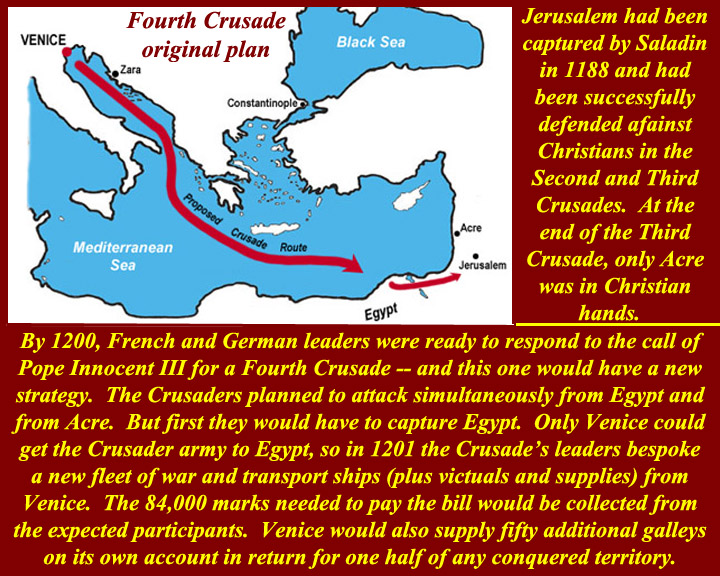
http://www.mmdtkw.org/CRUS0701-PlanAndDeal.jpg
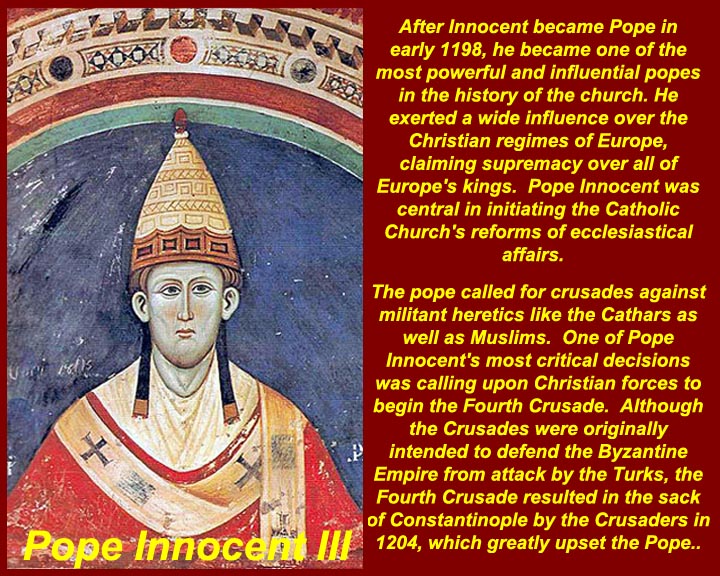
http://www.mmdtkw.org/CRUS0702a-InnocentIII.jpg
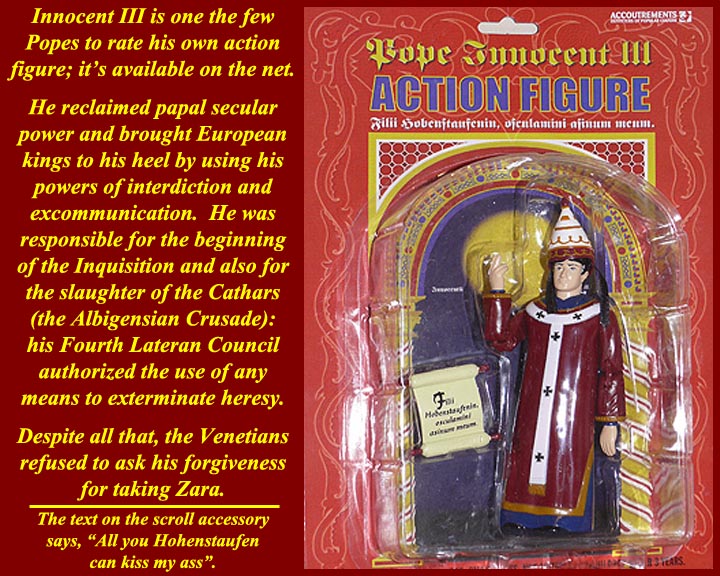
http://www.mmdtkw.org/CRUS0702b-InnocentAction.jpg
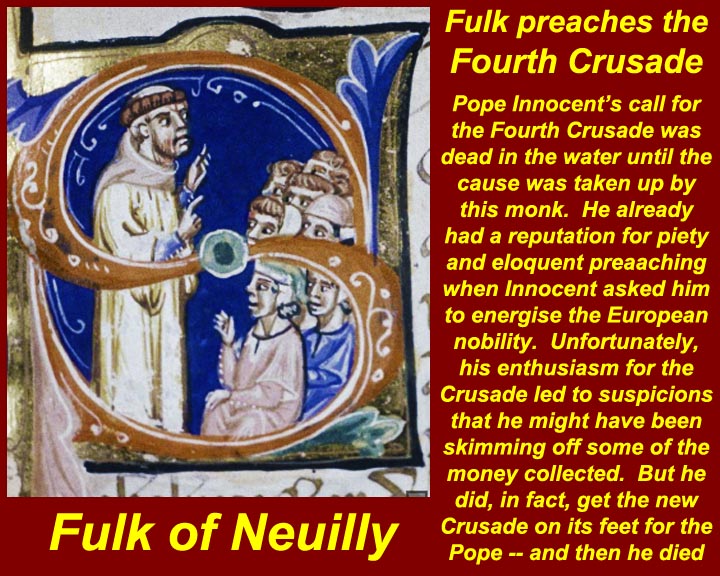
http://www.mmdtkw.org/CRUS0703-Fulk_of_Neuilly.jpg
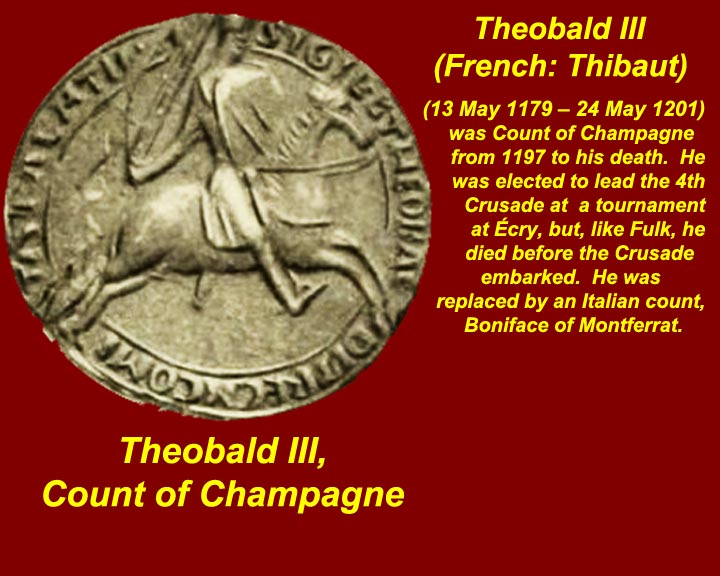
http://www.mmdtkw.org/CRUS0704-ThibaufIII_1198.jpg
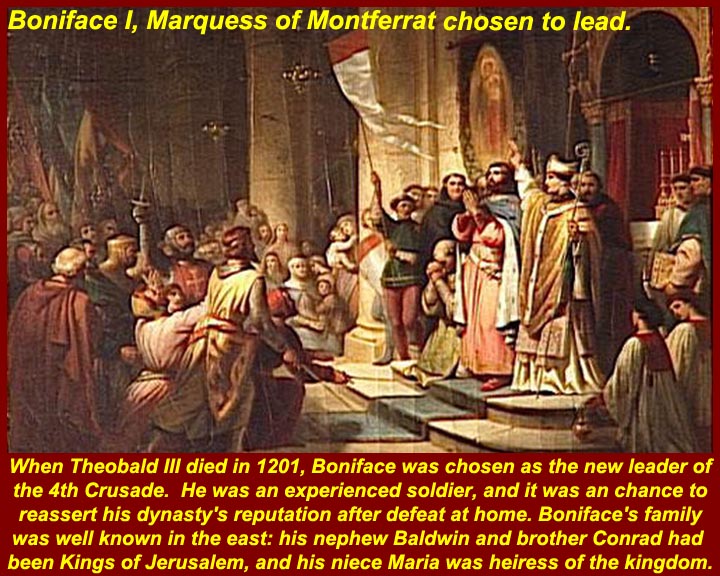
http://www.mmdtkw.org/CRUS0705-Boniface-of-Montferrat.jpg
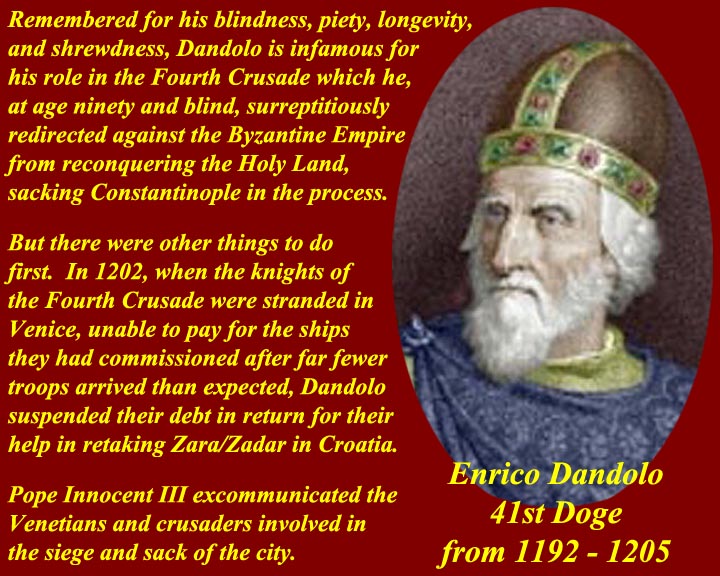
http://www.mmdtkw.org/CRUS0706-DandoloZara.jpg
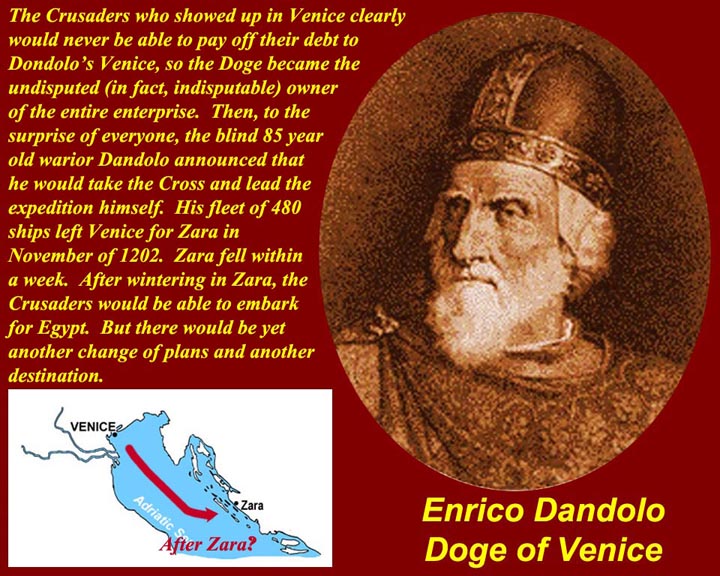
http://www.mmdtkw.org/CRUS0707-AfterZaraDandolo.jpg
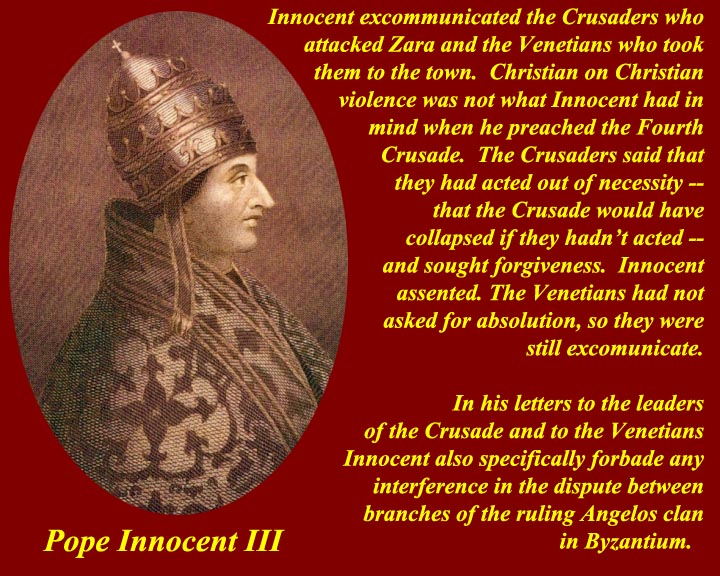
http://www.mmdtkw.org/CRUS0708-Innocent-iii.jpg
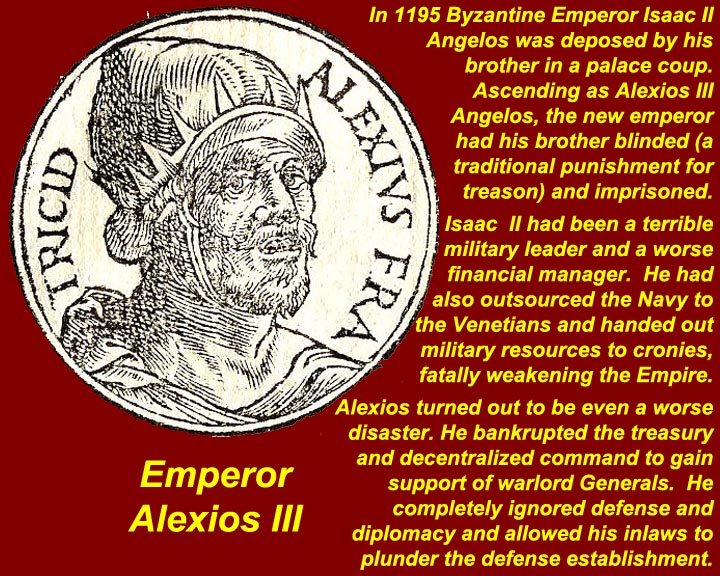
http://www.mmdtkw.org/CRUS0710-AlexiosIIIAngelos.jpg
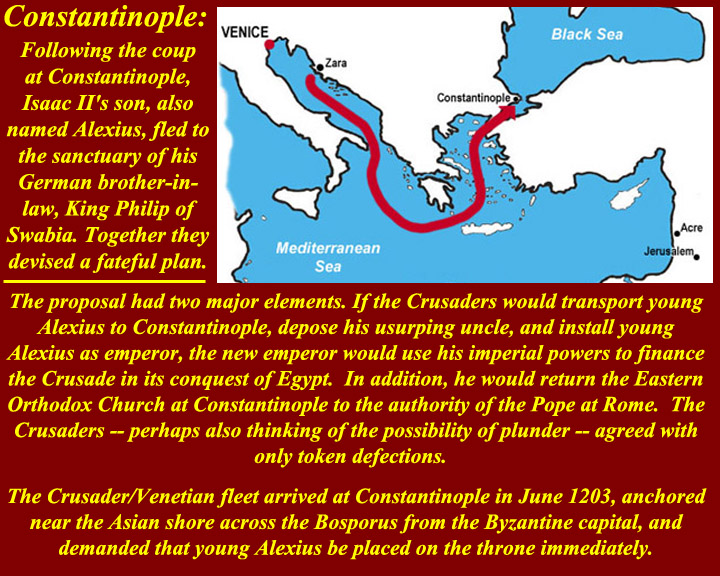
http://www.mmdtkw.org/CRUS0711-Constantinople-1.jpg
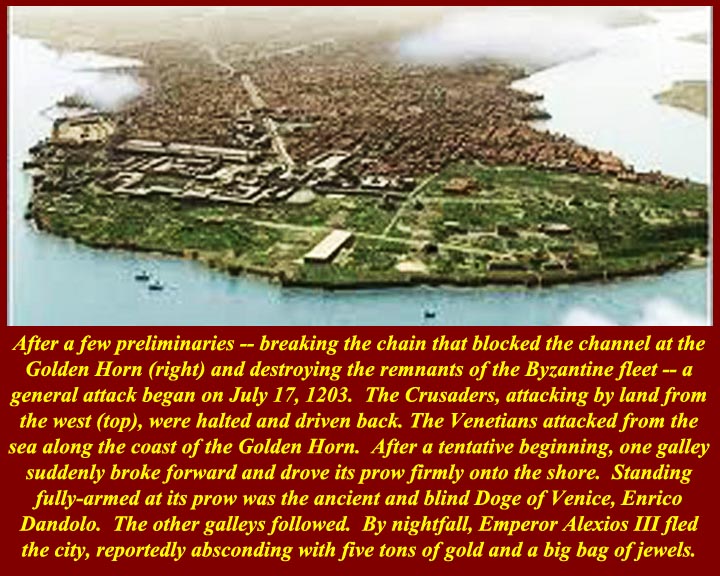
http://www.mmdtkw.org/CRUS0712-Constantinople-2.jpg
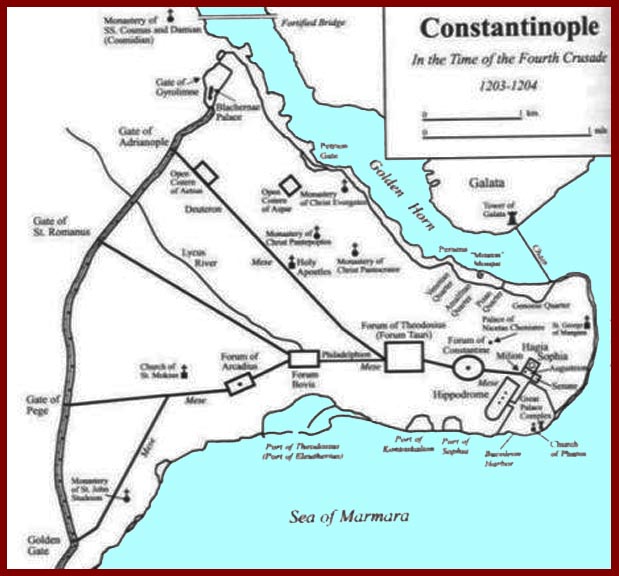
http://www.mmdtkw.org/CRUS0713-ConstantinopleMap3.jpg
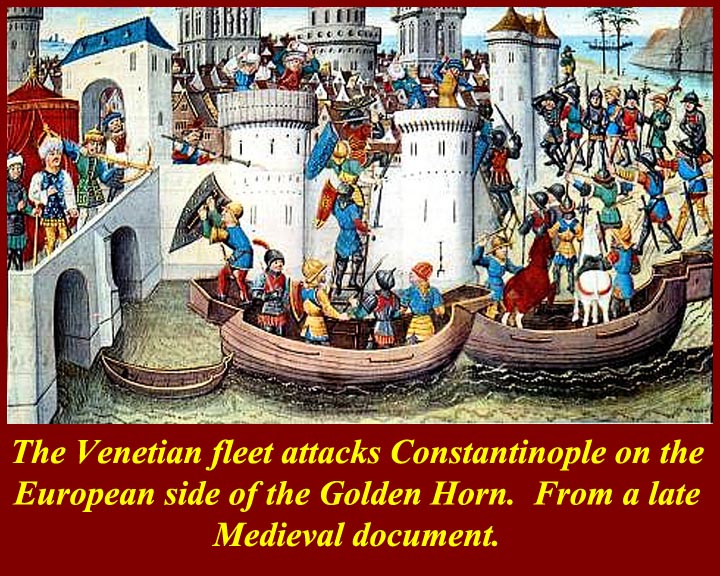
http://www.mmdtkw.org/CRUS0714-Conquest.jpg
http://www.mmdtkw.org/CRUS0715-DandoloAttack.JPG
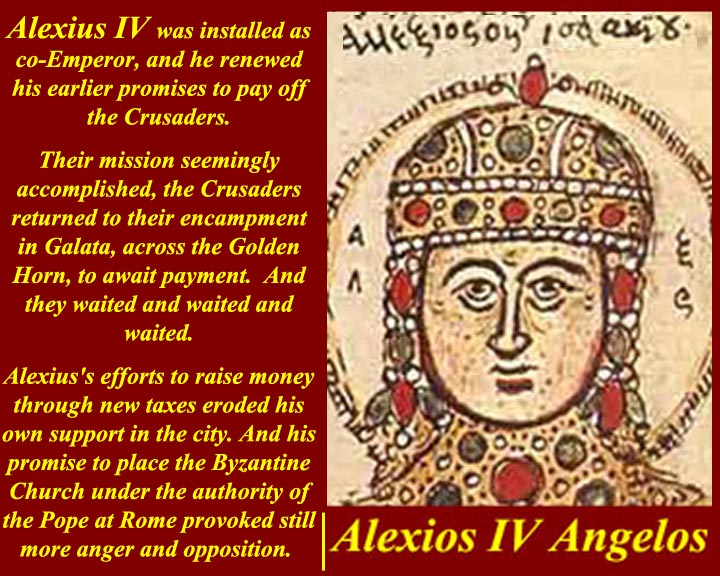
http://www.mmdtkw.org/CRUS0717-Waiting4Alexios4.jpg
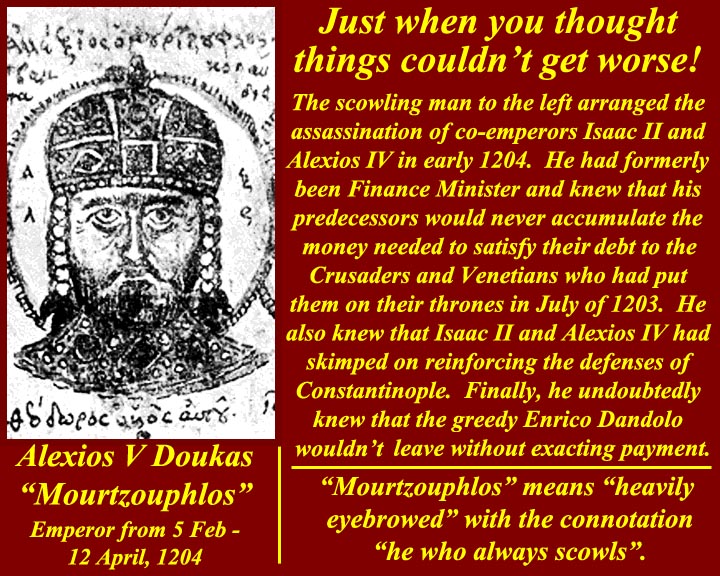
http://www.mmdtkw.org/CRUS0718-AlexiosIVMourtzouphlos.jpg
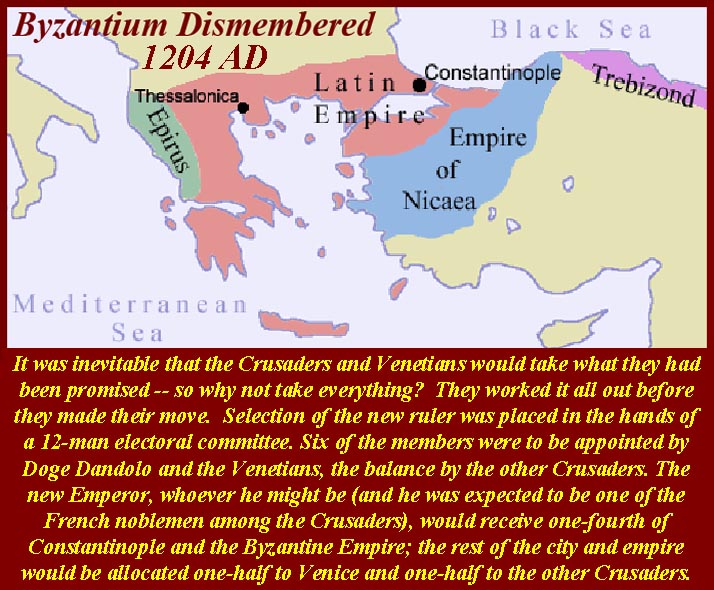
http://www.mmdtkw.org/CRUS0719-ByzantiumDismembered1204.jpg
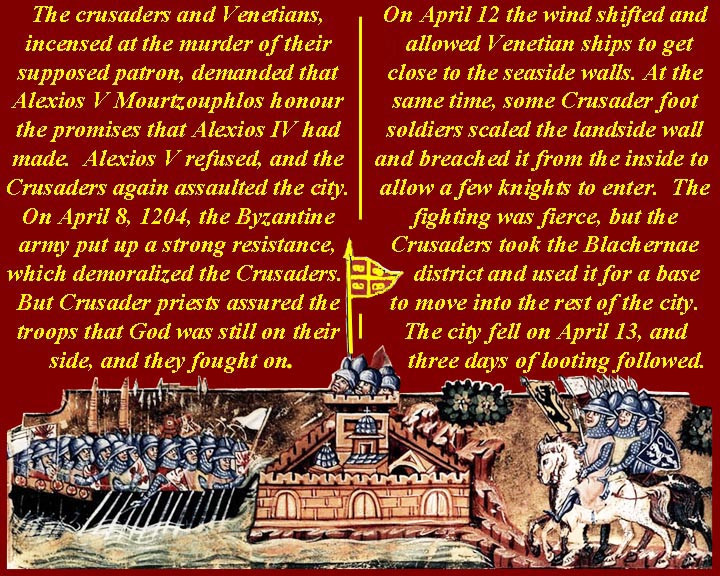
http://www.mmdtkw.org/CRUS0720-ByzantiumFalls.jpg
http://www.mmdtkw.org/CRUS0721-InnocentSubiacoFresco.JPG
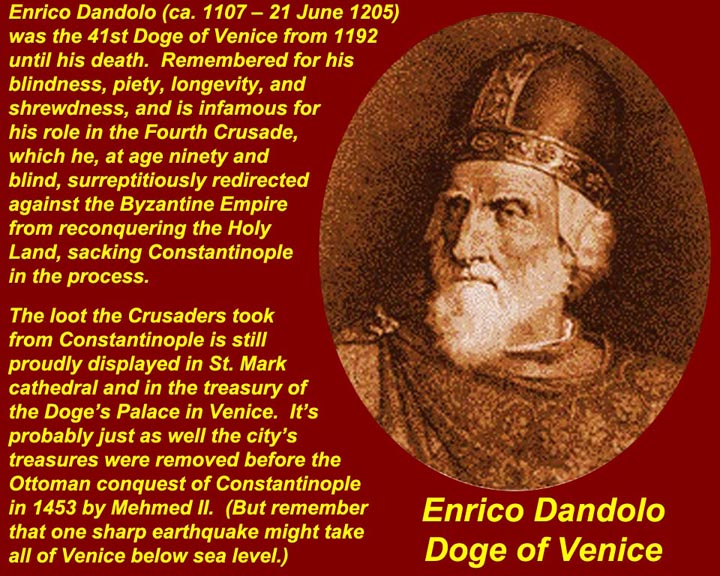
http://www.mmdtkw.org/CRUS0722-DogeEnricoDandolo.jpg
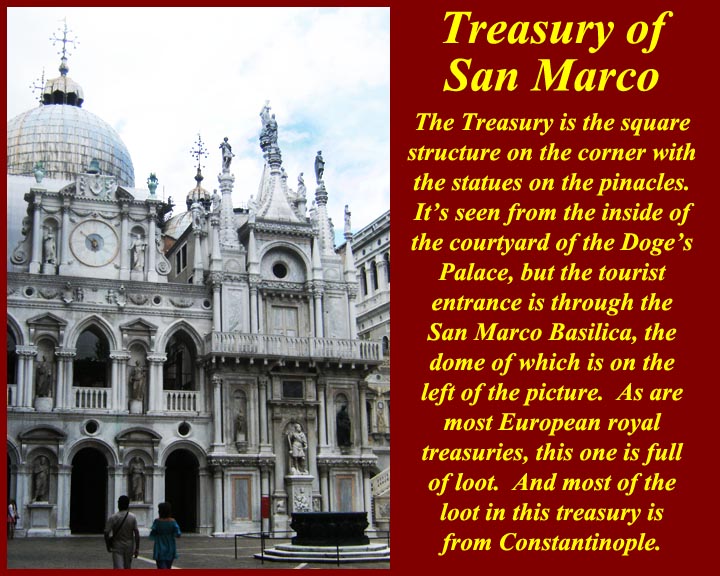
http://www.mmdtkw.org/CRUS0723-a-SanMarcoTreasury.jpg
Click on the reduced size images below or on associated links to increase their size.
Shown below are some of the artifacts in the San Marco Treasury
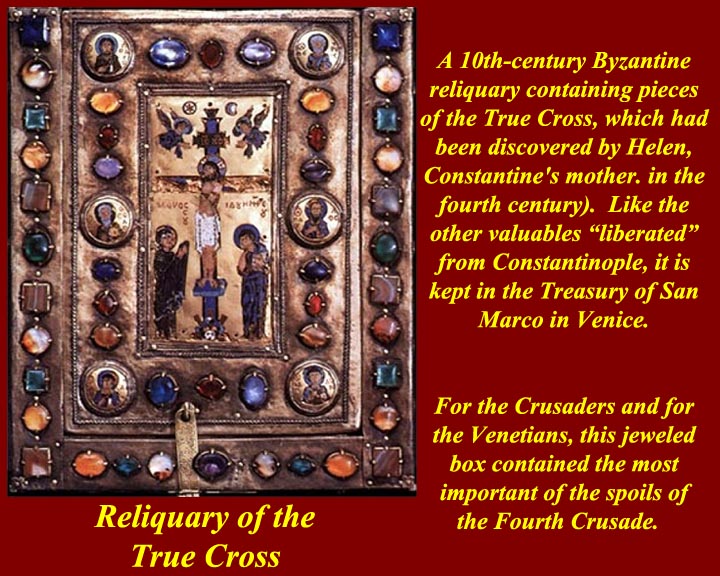
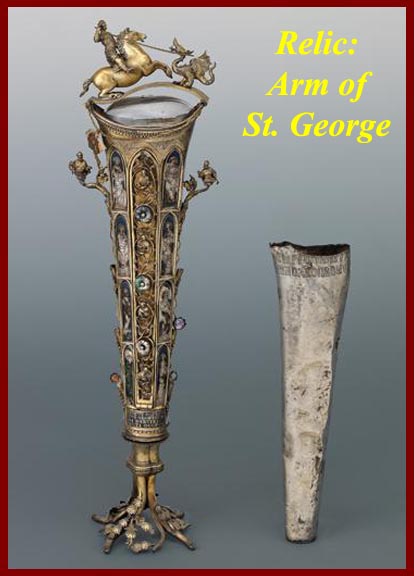
http://www.mmdtkw.org/CRUS0723-CrossReliquary.jpg
http://www.mmdtkw.org/CRUS0724-ArmStGeorge.jpg
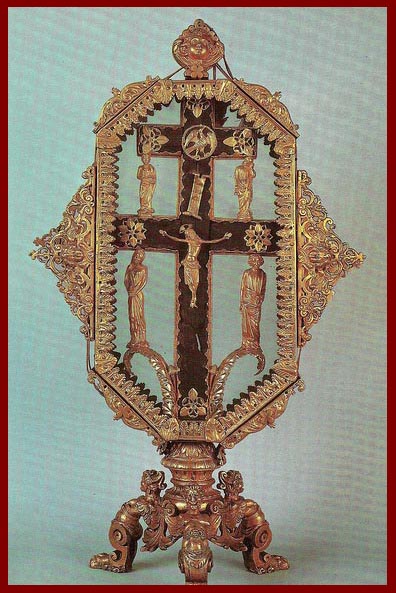
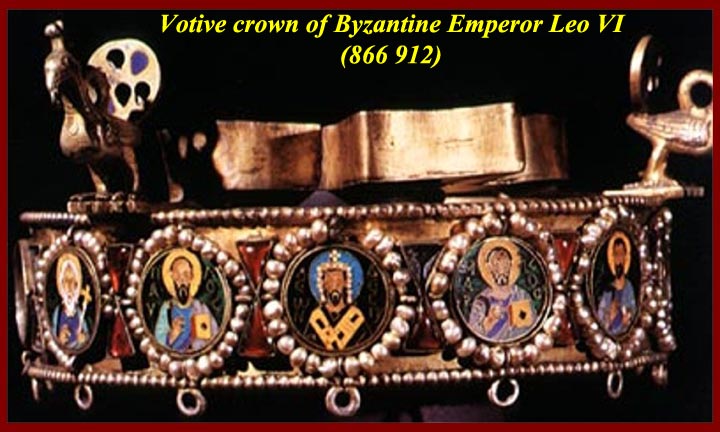
http://www.mmdtkw.org/CRUS0725-Crucifix.jpg
http://www.mmdtkw.org/CRUS0726-VotiveCrownOfLeo.jpg
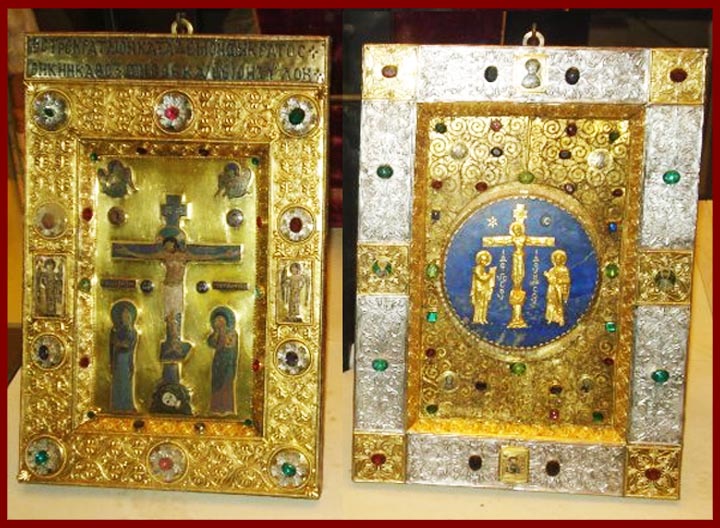
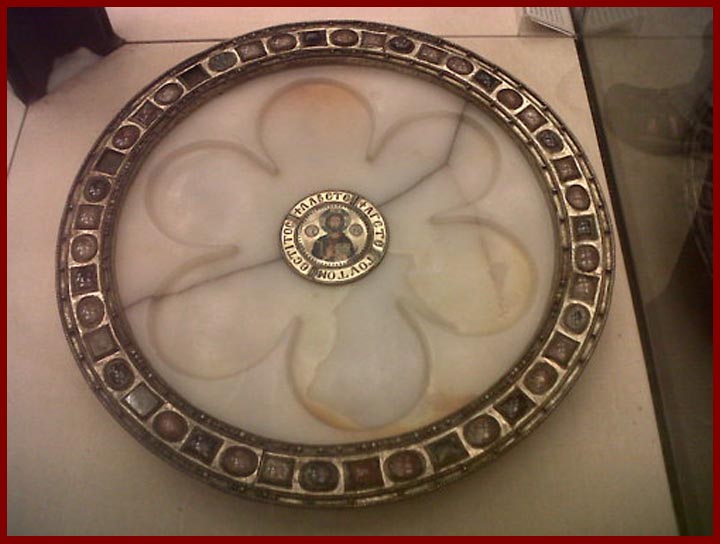
http://www.mmdtkw.org/CRUS0728a-JeweledPlates.jpg
http://www.mmdtkw.org/CRUS0728b-AlabasterPlate.jpg
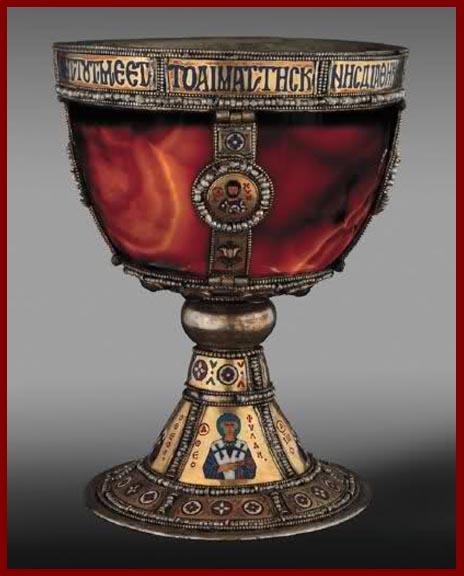
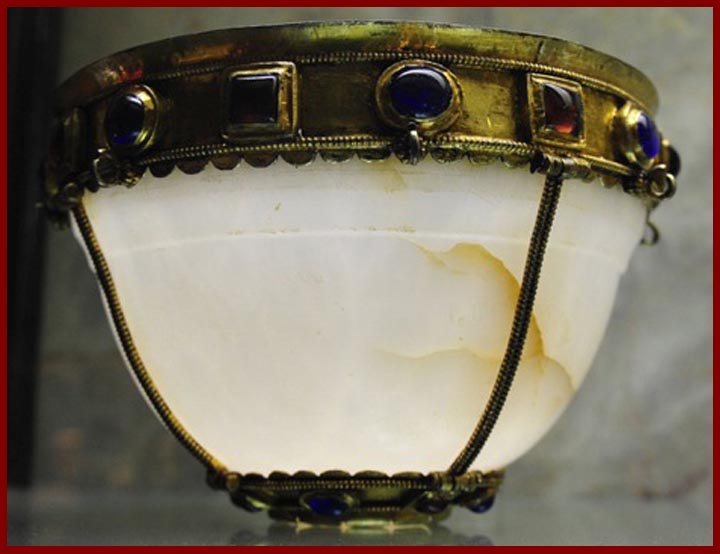
http://www.mmdtkw.org/CRUS0729-PatriarchChalice.jpg
http://www.mmdtkw.org/CRUS0730-TreasuryChalice1.jpg

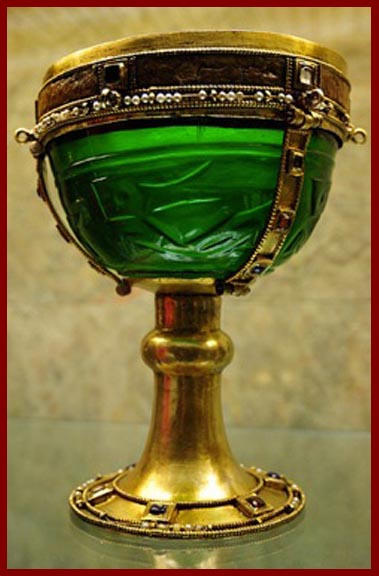
http://www.mmdtkw.org/CRUS0731-TreasuryChalice2.jpg
http://www.mmdtkw.org/CRUS0732-TreasuryChalice3.jpg
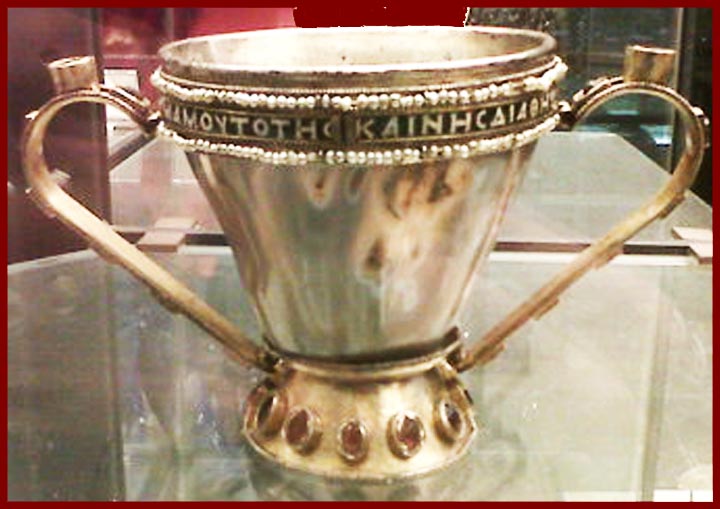
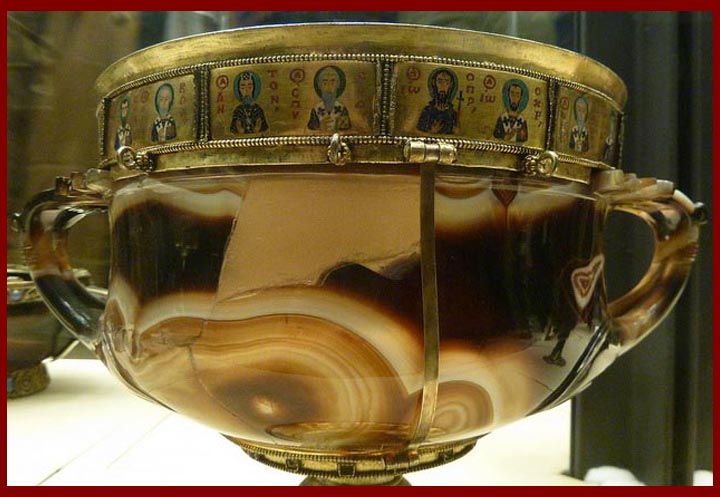
http://www.mmdtkw.org/CRUS0733-SilverCup.jpg
http://www.mmdtkw.org/CRUS0734-Cup1.jpg
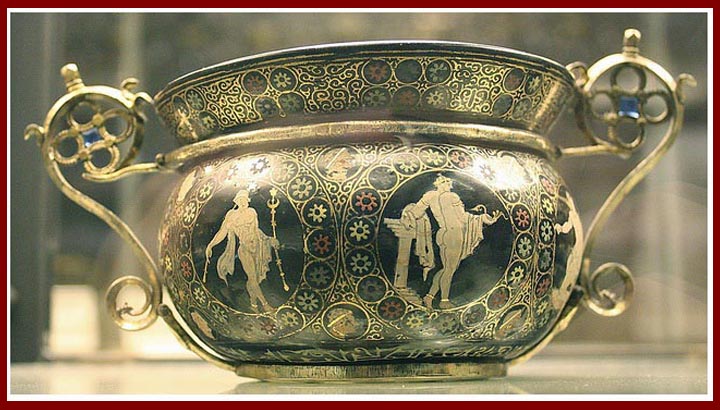
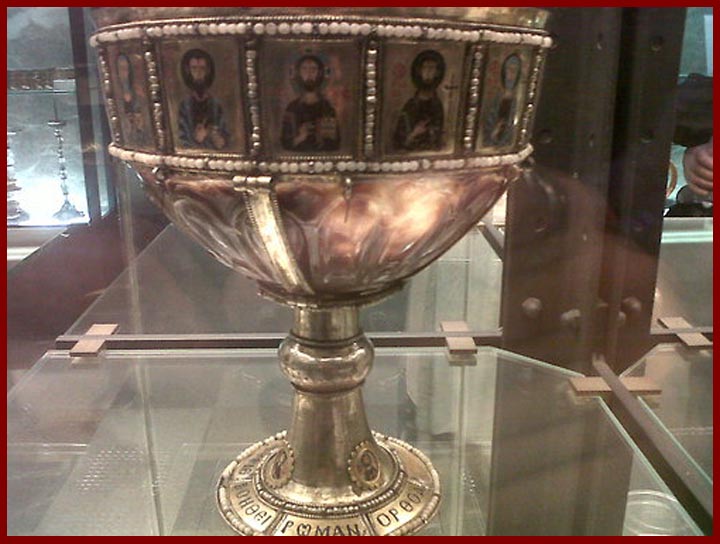
http://www.mmdtkw.org/CRUS0735-Cup2.jpg
Some of the looted Byzantine treasures are in the San Marco Basilica.
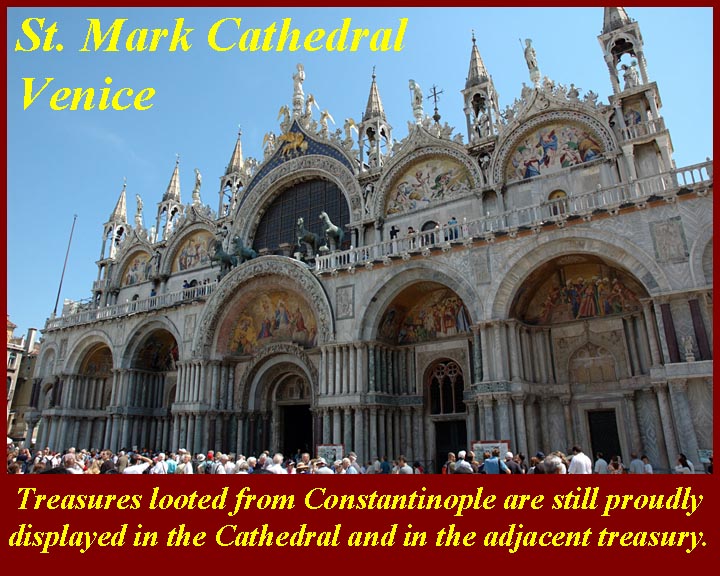
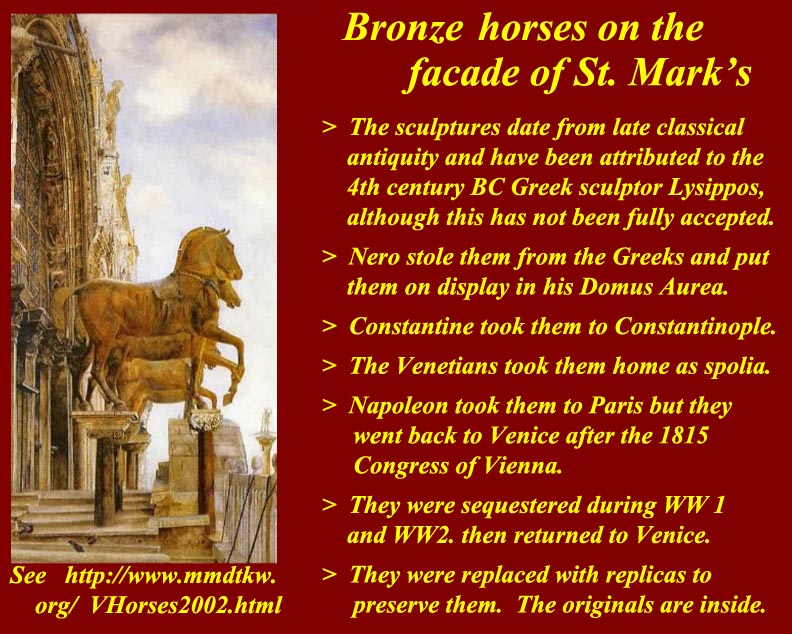
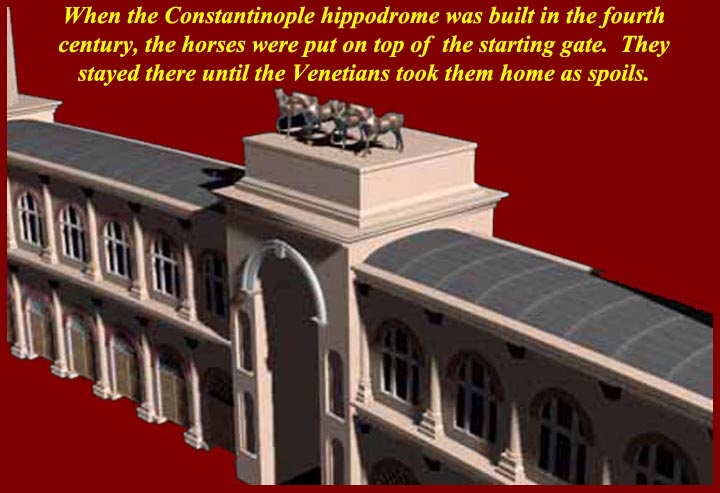
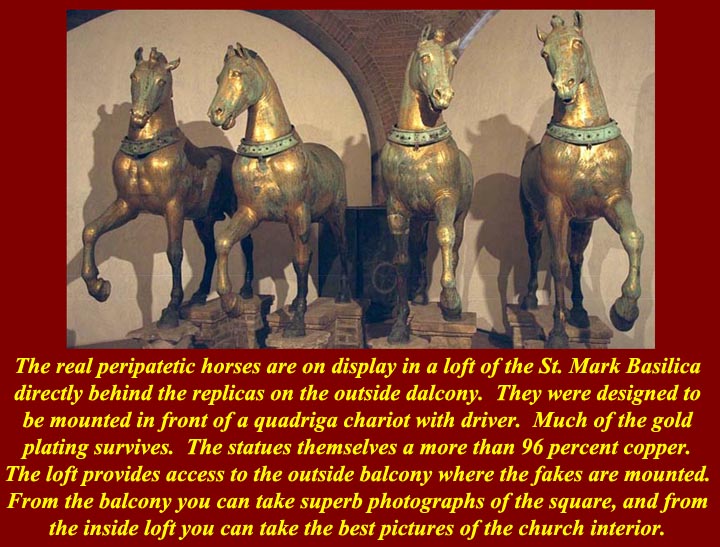
http://www.mmdtkw.org/CRUS0738-HorsesStMark1.jpg
http://www.mmdtkw.org/CRUS0739-HorsesStMark2.jpg
http://www.mmdtkw.org/CRUS0740-HorsesStMark3.jpg
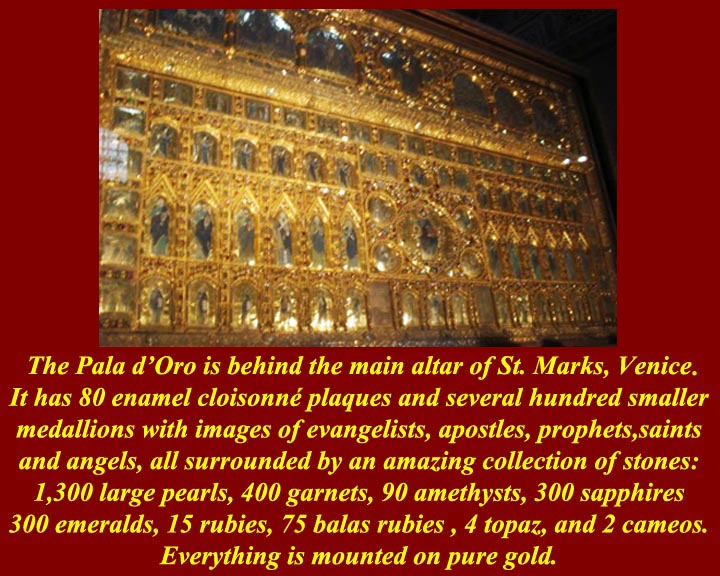
http://www.mmdtkw.org/CRUS0741-PalaDOro1.jpg
http://www.mmdtkw.org/CRUS0743-PalaDOro3Pantokrator.JPG
(click image or link to enlarge)
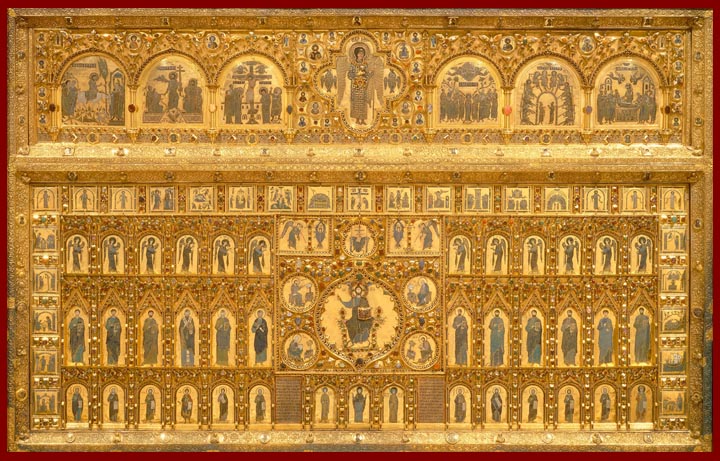
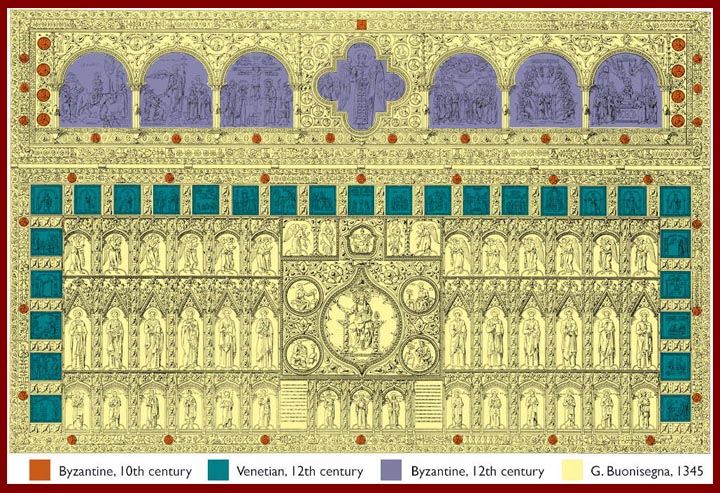
http://www.mmdtkw.org/CRUS0742-PalaDOro2.jpg
http://www.mmdtkw.org/CRUS0744-PalaDOro4Development.jpg
Other stolen stuff. The Venetians (like, it seems, everyone else at the time) were serial offenders. Aren't we glad that looting is a thing of the past? Aren't We?
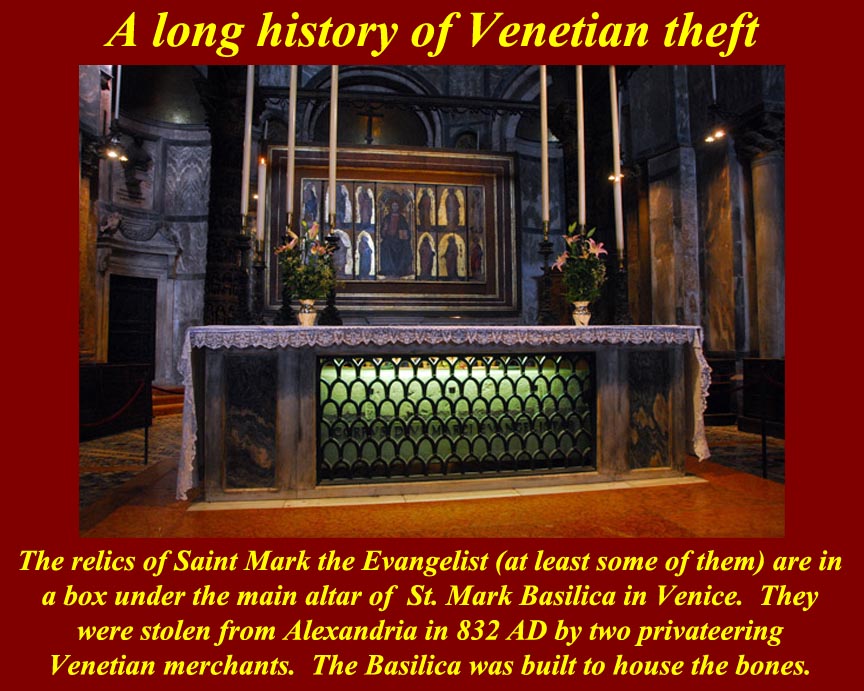
http://www.mmdtkw.org/CRUS0745-HistoryOfTheft1Mark.jpg
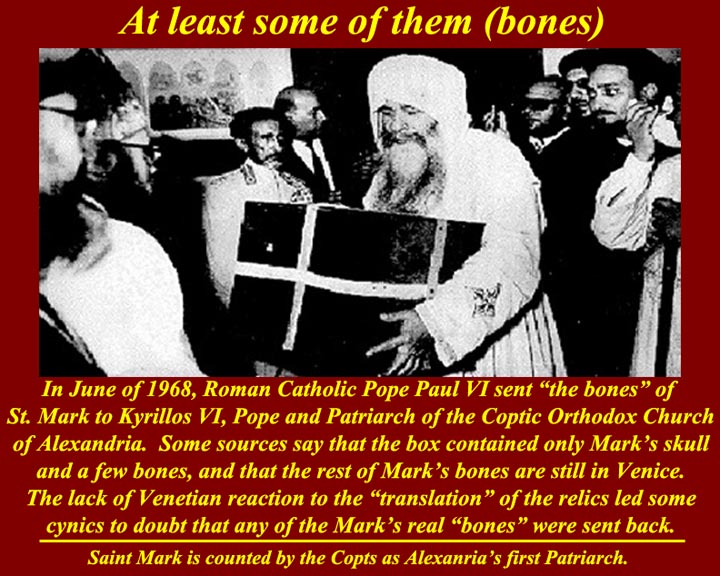
http://www.mmdtkw.org/CRUS0746-HistoryOfTheft2Mark.jpg
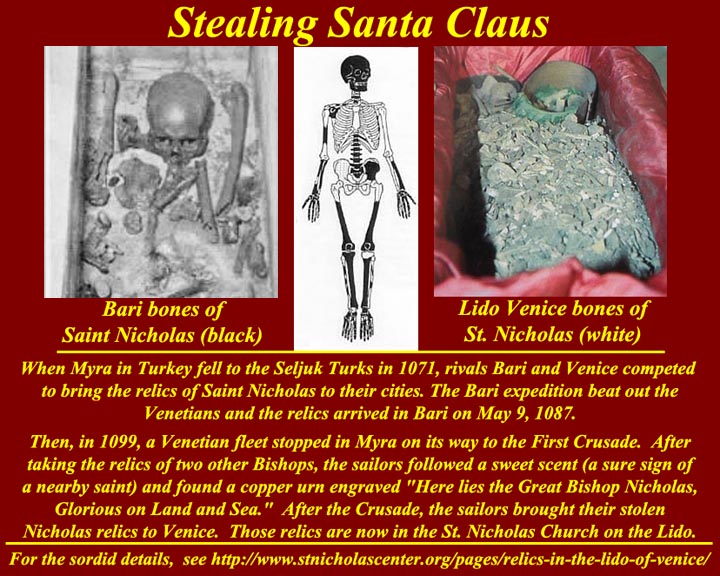
http://www.mmdtkw.org/CRUS0747-HistoryOfTheft3Nicholas.jpg
